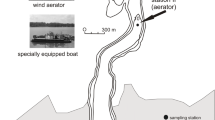Abstract
Water quality of Lake Balaton, particularly that of its south-western basin (the Keszthely-Bay), has been deteriorating faster and faster. The greatest transporter of inorganic nutrients to the Bay is the Zala River.
The lower valley of the river was part of the lake until about 200 years ago. Later, a large part of the area was turned to a wetland, while the smaller part dried up.
To retain the nutrients from Keszthely-Bay, the former marshland is now being reconstructed: the so-called Kis-Balaton Water Protection System (KBWPS). The first part of the System, the Hidvégi-Pond, has been operating since the middle of 1985. The second stage, the Fenéki-Pond, to be finished by the end of this century, is now under construction. The main purpose of the KBWPS is to gain enough time to build up the technology necessary for an adequate protection of Lake Balaton.
From the beginning of the operation of the Hidvégi-Pond a multidisciplinary research program has been carried out to monitor the hydrological, hydraulical, ecological, and biological processes in the reservoir. This program focused on nitrogen and phosphorus loadings and retention. Input and output loads were estimated from daily measurements. The mechanisms of retention were studied in special projects.
With the exception of TN, nutrient retention increased from year to year. In 1990, 96% of PO4-P, 87% NO3-N, and 58% of TP were retained.
This efficiency exceeds expectations. Retention of TN is the lowest (about 20%), due to N2-fixation by blue-green algae. However, the second stage needs to be implemented, since there is an additional external load from the watershed of the lower valley, and nutrient release takes place during decomposition of the organic matter which leaves the Hidvégi-Pond.
Similar content being viewed by others
References
Gorzó, Gy., 1990. A Kis-Balaton tározó nitrogénforgalmának vizsgálata (Investigations of nitrogen cycle of the Kis-Balaton reservoir). Vizügyi Közl. 3: 233–242.
Istvánovics, V., S. Herodek, F. Szilágyi & P. Pomogyi, 1990. Phosphate retention in the Kis-Balaton Protection System — a reconstructed wetland for eutrophication manegement of Lake Balaton (Hungary). Proc. Conference Use of Constructed Wetlands in Water Pollution Control Cambridge UK. 24–28 September. 579–582.
Joó, O. & Gy. Lotz, 1980. A Zala folyó szerepe a Balaton-tó eutrofizálódásában (Role of River Zala in eutrofication of Lake Balaton). Vizügyi Közl. 2: 226–256.
Pomogyi, P., 1989. Macrophyte communities of the Kis-Balaton Reservoir. Symp. Biol. Hung. Conservation and Manegement Lakes. Eds.: Salánki J. Herodek S. Akadémiai Kiadó: 505–515.
Pomogyi, P., 1990. Belastung eines touristish stark genutzten Gewaessers am Beispiel des Plattensees. Schulen + Sportstaetten 25: 24–29.
Pomogyi, P., 1991. A Kis-balaton Védörendszer kémiai, biológiai, anyagforgalmi vizsgálatai. Összefoglaló jelentés az 1985–1990 közötti kutatásokról (Chemical, biological, nutrient-cycle investigations of the Kis-Balaton Water Protection System. General Report on the research works 1985–1990). Szombathely-Keszthely, 258 pp.
Szilágyi, F. & L. Somlyódy, 1986. A Kis-balaton Védörendszer kémiai, biológiai, anyagforgalmi vizsgálatai. (Chemical, biological and mass balance studies of the Kis-Balaton Control System — VITUKI Report) VITUKI Jelentés No. 7612/3. Budapest, 80 pp.
Szilágyi, F., L. Somlyódy & L. Koncsos, 1987. A Kis-balaton Védörendszer kémiai, biológiai, anyagforgalmi vizsgálatai. (Chemical, biological and mass balance studies of the Kis-Balaton Control System — VITUKI Report) VITUKI Jelentés. No. 7612/3/8 Budapest, 137 pp.
Szilágyi, F., L. Somlyódy & L. Koncsos, 1990. Operation of the Kis-Balaton reservoir: evaluation of nutrient removal rates. In P. Bird & J. F. Talling (eds), Trophic Relationships in Inland Waters. Developments in Hydrobiology 53. Kluwer Academic Publishers, Dordrecht: 297–306. Reprinted from Hydrobiologia 191.
Author information
Authors and Affiliations
Rights and permissions
About this article
Cite this article
Pomogyi, P. Nutrient retention by the Kis-Balaton Water Protection System. Hydrobiologia 251, 309–320 (1993). https://doi.org/10.1007/BF00007190
Issue Date:
DOI: https://doi.org/10.1007/BF00007190




